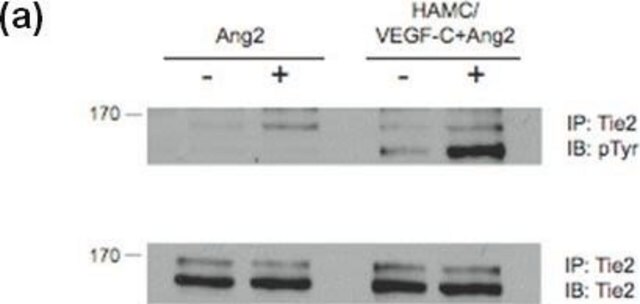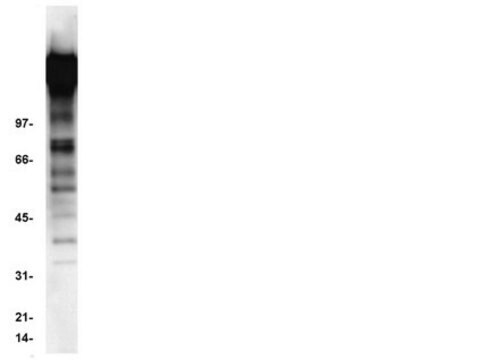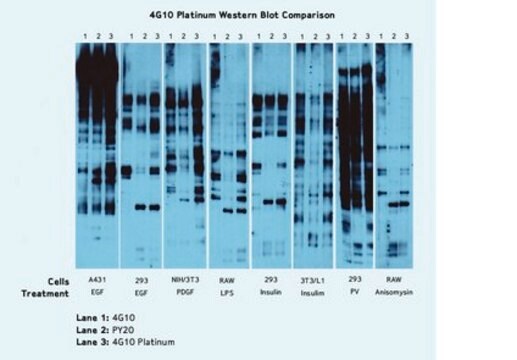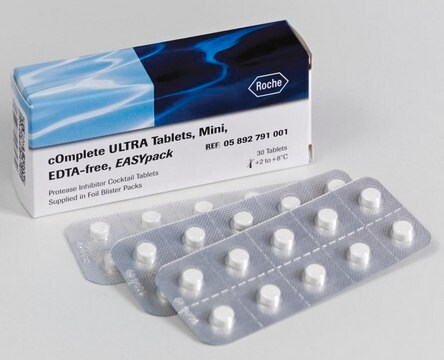16-282
Anti-Phosphotyrosine Antibody, clone 4G10®, Magnetic Bead Conjugate
clone 4G10®, from mouse
Sign Into View Organizational & Contract Pricing
All Photos(2)
About This Item
UNSPSC Code:
12352203
eCl@ss:
32160702
NACRES:
NA.41
Recommended Products
biological source
mouse
Quality Level
antibody form
purified antibody
antibody product type
primary antibodies
clone
4G10®, monoclonal
species reactivity (predicted by homology)
all
technique(s)
immunoprecipitation (IP): suitable
isotype
IgG2bκ
shipped in
wet ice
target post-translational modification
phosphorylation (pTyr)
Gene Information
human ... PID1(55022)
General description
Tyrosine phosphorylation is considered as one of the key steps in signal transduction and regulation of enzymatic activity. Some of the tyrosine residues can be tagged with a phosphate group (phosphorylated) by protein kinases. (In its phosphorylated state, it is referred to as phosphotyrosine.).The advent of anti-phosphotyrosine antibodies is one of significant events in signal transduction research. Before the availability of anti-phosphotyrosine antibodies, tyrosyl phospyhorylation of proteins and enzymes was investigated through hazardous and time-consuming radioactive experiments. Anti-phosphotyrosine antibodies are commonly used in western blots after the targeted proteins have been immunoprecipitated to measure the tyrosyl phosphorylation of the proteins. Anti-phosphotyrosine antibodies are also directly used on cell lysate to examine the overall change of tyrosine phosphorylation level in reponse to various treatments.
Specificity
This antibody recognizes tyrosine-phosphorylated proteins from all species
Immunogen
Phosphotyramine-KLH
Application
Detect Phosphotyrosine using this Anti-Phosphotyrosine Antibody, clone 4G10, Magnetic Bead Conjugate validated for use in IP.
Research Category
Signaling
Signaling
Research Sub Category
General Post-translation Modification
General Post-translation Modification
Quality
100 μg of NIH3T3 whole cell lysate stimulated with 100 ng/mL PDGF (10 minutes) was immunoprecipitated (IP) using either anti-mouse IgG (Cat. No. 12-371) (lane 1), or Anti-Phosphotyrosine, Magnetic Bead Conjugate
(Lane 2).
(Lane 2).
Target description
Dependent upon the molecular weight of the tyrosine phosphorylated protein being detected.
Physical form
20% slurry; 1xPBS, 0.05% sodium azide. Sufficient for 10 IPs.
Format: Purified
Protein G-Sepharose Chromatography
Storage and Stability
Stable for 1 year at 2-8ºC from date of receipt.
Note: DO NOT FREEZE
Note: DO NOT FREEZE
Analysis Note
Control
NIH3T3 whole cell lysate stimulated with 50 ng/mL PDGF (5 minutes)
NIH3T3 whole cell lysate stimulated with 50 ng/mL PDGF (5 minutes)
Legal Information
4G10 is a registered trademark of Upstate Group, Inc.
Disclaimer
Unless otherwise stated in our catalog or other company documentation accompanying the product(s), our products are intended for research use only and are not to be used for any other purpose, which includes but is not limited to, unauthorized commercial uses, in vitro diagnostic uses, ex vivo or in vivo therapeutic uses or any type of consumption or application to humans or animals.
Not finding the right product?
Try our Product Selector Tool.
Storage Class
12 - Non Combustible Liquids
wgk_germany
WGK 2
Certificates of Analysis (COA)
Search for Certificates of Analysis (COA) by entering the products Lot/Batch Number. Lot and Batch Numbers can be found on a product’s label following the words ‘Lot’ or ‘Batch’.
Already Own This Product?
Find documentation for the products that you have recently purchased in the Document Library.
M Whitfield et al.
Reproduction (Cambridge, England), 154(6), 827-842 (2017-10-04)
Lipid metabolism disorders (dyslipidemia) are causes of male infertility, but little is known about their impact on male gametes when considering post-testicular maturation events, given that studies concentrate most often on endocrine dysfunctions and testicular consequences. In this study, three-month-old
Our team of scientists has experience in all areas of research including Life Science, Material Science, Chemical Synthesis, Chromatography, Analytical and many others.
Contact Technical Service








